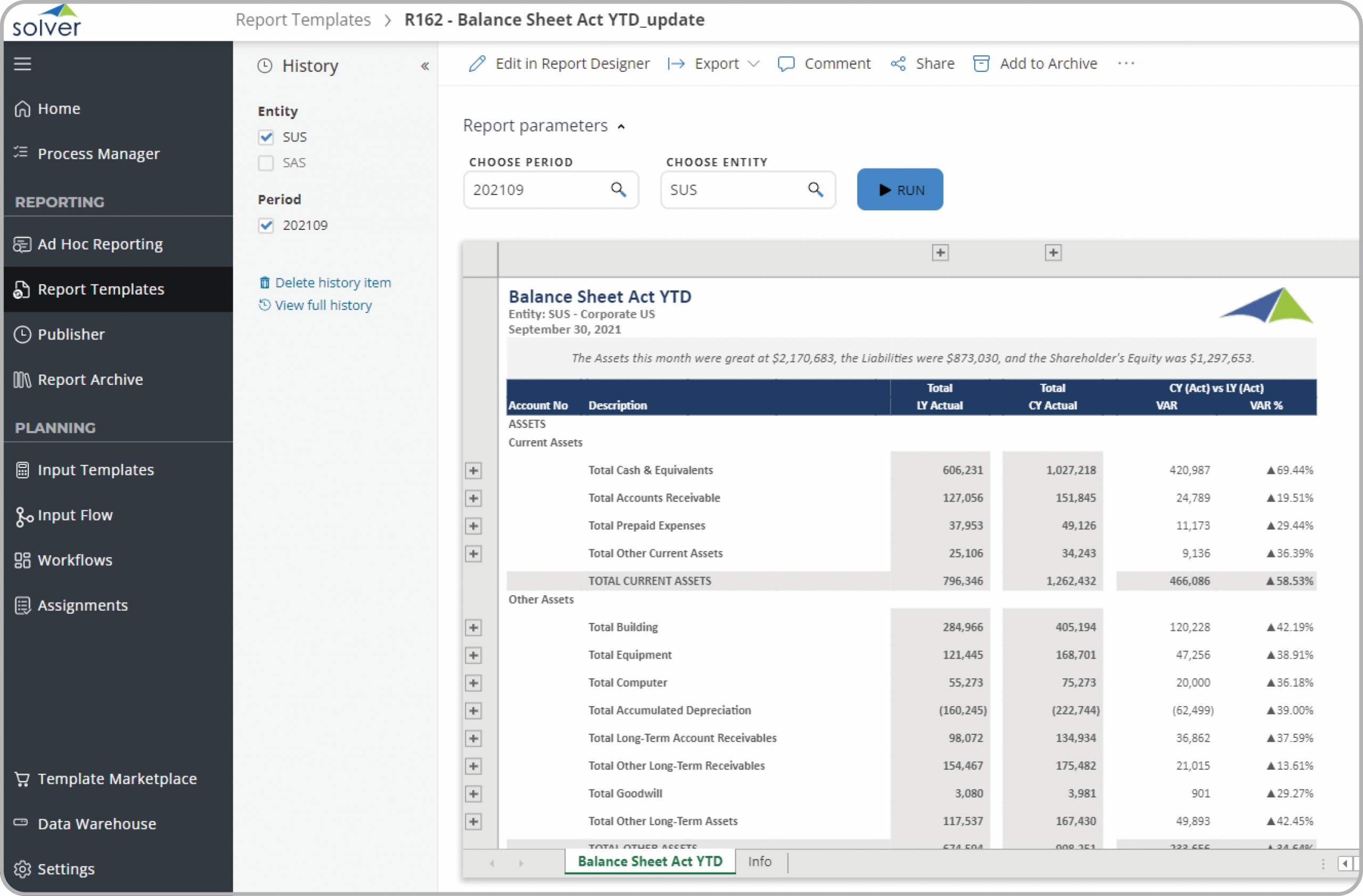Using the Balance Sheet with Last Year Variances Report to Streamline the Monthly Reporting Process
How can
Financial Statement
s Drive Faster and Better Decisions? As Controllers increasingly become leaders in the Monthly Reporting Process, they must rely on modern self-service corporate performance management (CPM) and business intelligence (BI) tools. Using interactive Financial Statements like the Balance Sheet Report with Last Year Variance template shown below enables them and users from the executive teams to experience near real time balance sheet metrics and results that help drive faster and better decisions.
Who uses
Balance Sheet Report with Last Year Variance
s and What are Some Key Analytical Features? In today’s fast-paced business environment, Controllers are under high pressure to supply end users like senior leaders and financial executives with timely and concise Financial Statements. Companies use key features like the ones below to support their users with effective analysis that helps drive risk control and investment optimization across subsidiaries:
- Dynamic balance sheet report driven by parameters
- Professional formatting enabled by cloud connector Excel report designer with drill down to transaction detail for root-cause analysis
- Variance analysis in amount and percent, and with indicators
The Balance Sheet Report with Last Year Variance template can be used as a key element of the Monthly Reporting process: [caption id="" align="alignnone" width="2560"]
 Example of a Balance Sheet Report with Last Year Variance to Streamline the Monthly Reporting Process[/caption] The Balance Sheet Report with Last Year Variance is a ready-to-use Financial Statement from the
Solver Marketplace.
A Brief Description of the
Balance Sheet Report with Last Year Variance
Template Financial Statements like the one seen in the image above are interactive and parameter driven and typically contain sections with automatic narrative and rows that expand to see account-level data for the current month and the same month in the prior year. One of the important features that aid the user in the analysis process is the ability to access self-service web-based variance reports that any user with security rights can run on demand to analyze asset, liability and equity data. Balance Sheet Report with Last Year Variances is often used in conjunction with balance sheet trend reports, cash flow and profit & loss reports, KPI dashboards and cash flow budget models.
Data Integration to Transaction Systems Most organizations these days want automated and streamlined
planning,
reporting and
analysis. However, many of the benefits described earlier rely on best of breed Corporate Performance Management (CPM) tools and/or Business Intelligence (BI) capabilities as well as data marts or data warehouses that use pre-built integrations to the organization’s ERP system. Oftentimes, they also need integrations to other key data sources like CRM, subscription systems, payroll tools, etc. Modern, cloud-based ERPs like Microsoft Dynamics 365 Finance (D365 Finance), Microsoft Dynamics 365 Business Central (D365 BC), Sage Intacct, Acumatica, Netsuite and SAP have robust APIs which allow for dynamic integrations to CPM and BI tools that are fully automated and flexible to run on a schedule or on-demand.
Additional Resources to Aid with Research of Templates, CPM and BI Tools
Example of a Balance Sheet Report with Last Year Variance to Streamline the Monthly Reporting Process[/caption] The Balance Sheet Report with Last Year Variance is a ready-to-use Financial Statement from the
Solver Marketplace.
A Brief Description of the
Balance Sheet Report with Last Year Variance
Template Financial Statements like the one seen in the image above are interactive and parameter driven and typically contain sections with automatic narrative and rows that expand to see account-level data for the current month and the same month in the prior year. One of the important features that aid the user in the analysis process is the ability to access self-service web-based variance reports that any user with security rights can run on demand to analyze asset, liability and equity data. Balance Sheet Report with Last Year Variances is often used in conjunction with balance sheet trend reports, cash flow and profit & loss reports, KPI dashboards and cash flow budget models.
Data Integration to Transaction Systems Most organizations these days want automated and streamlined
planning,
reporting and
analysis. However, many of the benefits described earlier rely on best of breed Corporate Performance Management (CPM) tools and/or Business Intelligence (BI) capabilities as well as data marts or data warehouses that use pre-built integrations to the organization’s ERP system. Oftentimes, they also need integrations to other key data sources like CRM, subscription systems, payroll tools, etc. Modern, cloud-based ERPs like Microsoft Dynamics 365 Finance (D365 Finance), Microsoft Dynamics 365 Business Central (D365 BC), Sage Intacct, Acumatica, Netsuite and SAP have robust APIs which allow for dynamic integrations to CPM and BI tools that are fully automated and flexible to run on a schedule or on-demand.
Additional Resources to Aid with Research of Templates, CPM and BI Tools
- Templates from Solver that are pre-built and that work out-of-the-box using the Solver CPM cloud. Click here.
- Template examples: You find more than 500 CPM and BI Template examples here.
- Interactive Dashboard examples: Try Power BI dashboard templates from Solver here.
- Software evaluation and selection:
- Creating efficient processes:
January 23, 2022
TAGS:
Solver,
Microsoft,
Acumatica,
financial statement,
Netsuite,
D365 BC,
GP,
QuickStart,
report templates,
last year,
ax,
Microsoft Dynamics,
Controllers,
Dynamics 365,
Dynamics 365 Business Central,
Sage Intacct,
General Ledger,
dashboard templates,
KPI,
budget templates,
Oracle,
dynamics 365 finance,
SAP,
templates,
Sage,
business one,
financial templates,
D365,
NAV,
Intacct,
BI,
Variance,
Monthly Reporting,
GL,
Balance Sheet,
CPM,
SL,
dynamics,
EPM,
financial report,
Balance Sheet Report with Last Year Variance,
senior leaders and financial executives

